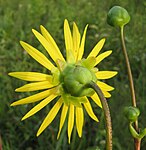Phyllary
In botanical terminology, a phyllary, also known an involucral bract or tegule, is a single bract of the involucre of a composite flower.[1][2][3] The involucre is the grouping of bracts together. Phyllaries are reduced leaf-like structures that form one or more whorls immediately below a flower head.[1]
Function
Phyllaries provide protection to developing flowers and fruits.slugs.[5]
They sometimes assist in the dispersal of fruits.
Structure and arrangement
Phyllary morphology is useful in plant identification as between species of the Asteraceae family, they may vary in number, shape, width, length, hairiness, presence of glands, or texture.[3]
-
Balsamorhiza hookeri phyllaries are widely separated, hairy, stiff, and point away from the stem.
-
These Silphium pinnatifidum phyllaries are graduated, with those closer to the flower longer than the outer layers.
References
- ^ a b "Jepson Herbarium: Jepson Flora Project: Jepson eFlora: Glossary". ucjeps.berkeley.edu. Retrieved 26 May 2019.
- ^ "NYGB Steele Herbarium Glossary". Retrieved May 23, 2019.
- ^ a b Reznicek, A.A.; Voss, E.G.; Walters, B.S. "Asteraceae". michiganflora.net. Michigan Flora. Retrieved 26 May 2019.
- ^ a b "Glossary of botanical terms for Compositae". www.kew.org. Retrieved 26 May 2019.
- S2CID 46343283.
- S2CID 6102531.
- ^ Clark, Patterson. "Burdock: Sowing seeds with fur and bur". The Washington Post. Retrieved 26 May 2019.



